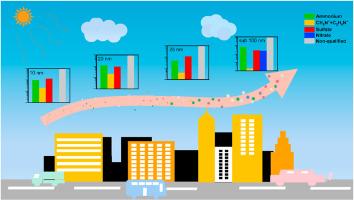Size-dependent chemical composition of atmospheric nanoparticles in urban Beijing during springtime
Abstract
Atmospheric nanoparticle growth is a critical bridge between aerosol to clouds and climate. However, current mechanisms for nanoparticle growth are not yet fully understood due to unknown size-resolved chemical composition during the growth process. Here, we present comprehensive field measurements of the size-resolved chemical composition of the atmospheric nanoparticle growth in the size range from 10 to 100 nm using a custom-made Nanoparticle Chemical Ionization Mass Spectrometer (NPCIMS). The typical chemical compositions of nanoparticles are quantified in both positive and negative ion modes during growth processes after sensitivity calibration. The quantification results for chemical compositions show that CHO organics account for ∼80% of the newly formed particle in the growth process with diameters from 10 to 25 nm. However, the nitrate component is rarely observed during the nanoparticle growth under size-resolved mode (10–25 nm), indicating the little contribution of the nitrate component to growth at diameters below 25 nm. Different from the contribution of aminium salts to nanoparticle growth according to the previous urban observations in Mexico, the newly formed particle growth in urban Beijing is dominated by ammonium, sulfate, and organic components in the size-resolved modes (10–25 nm) in springtime.


 求助内容:
求助内容: 应助结果提醒方式:
应助结果提醒方式:


